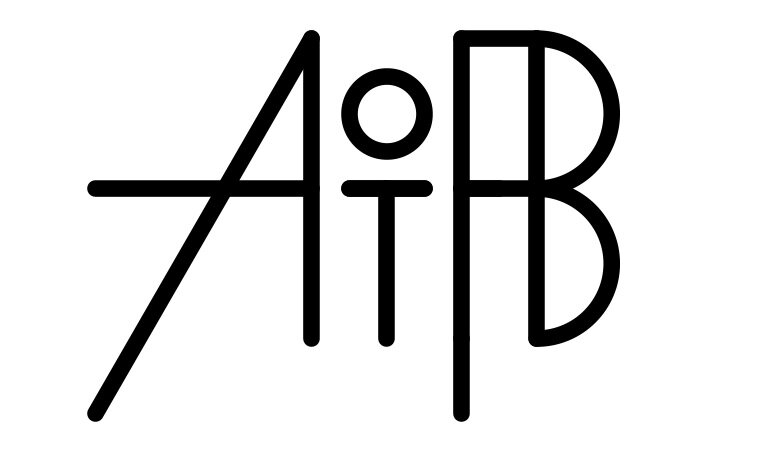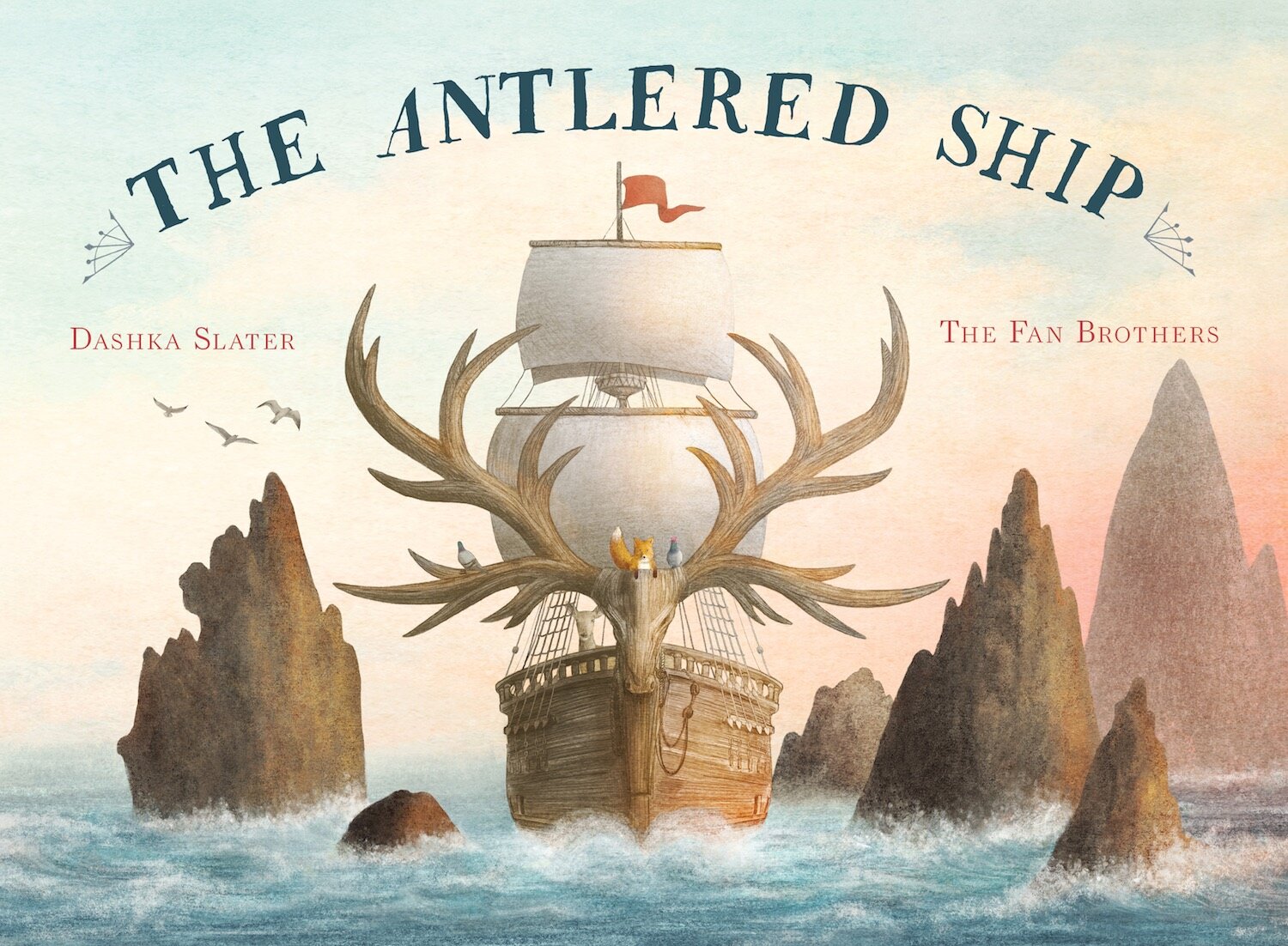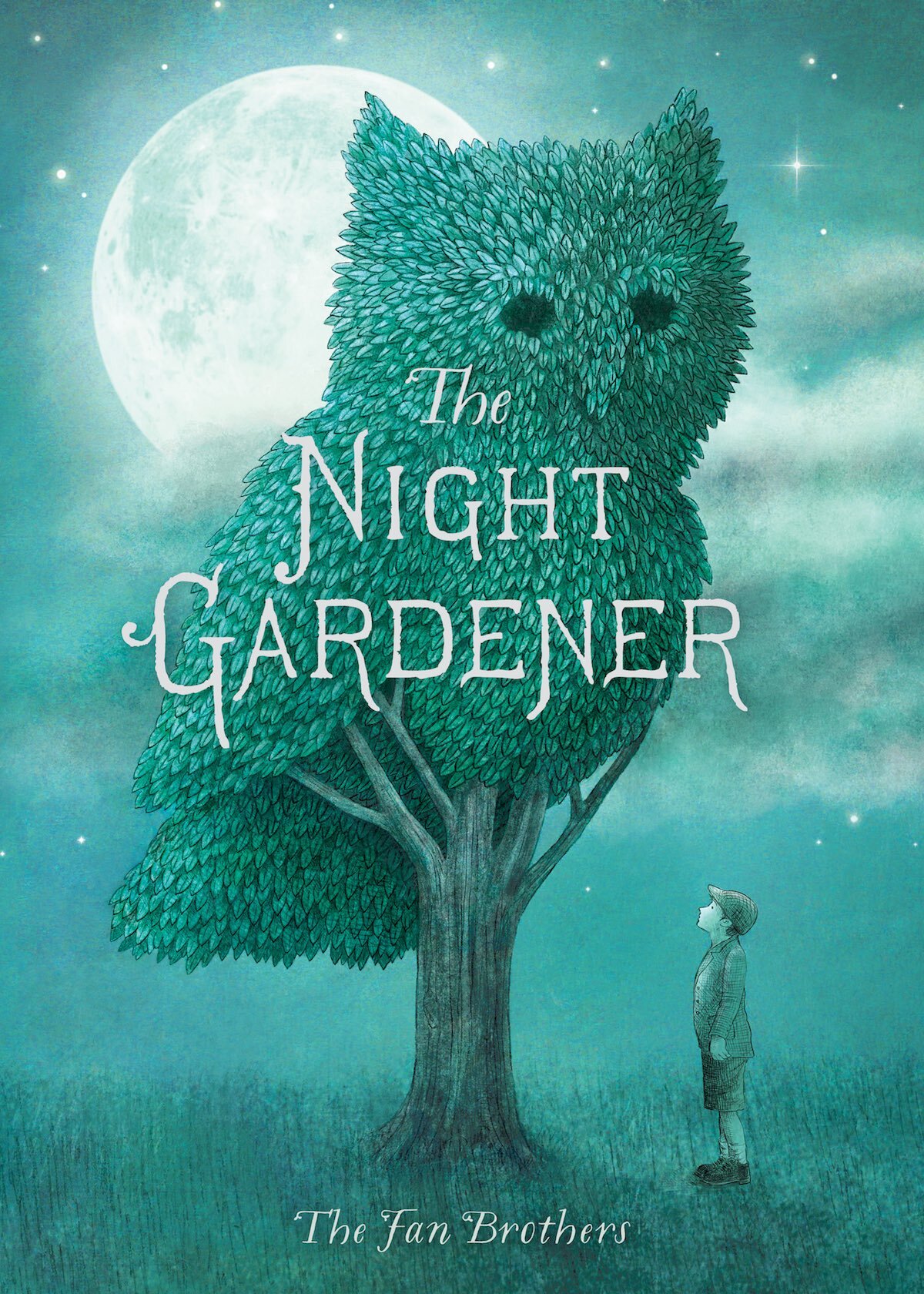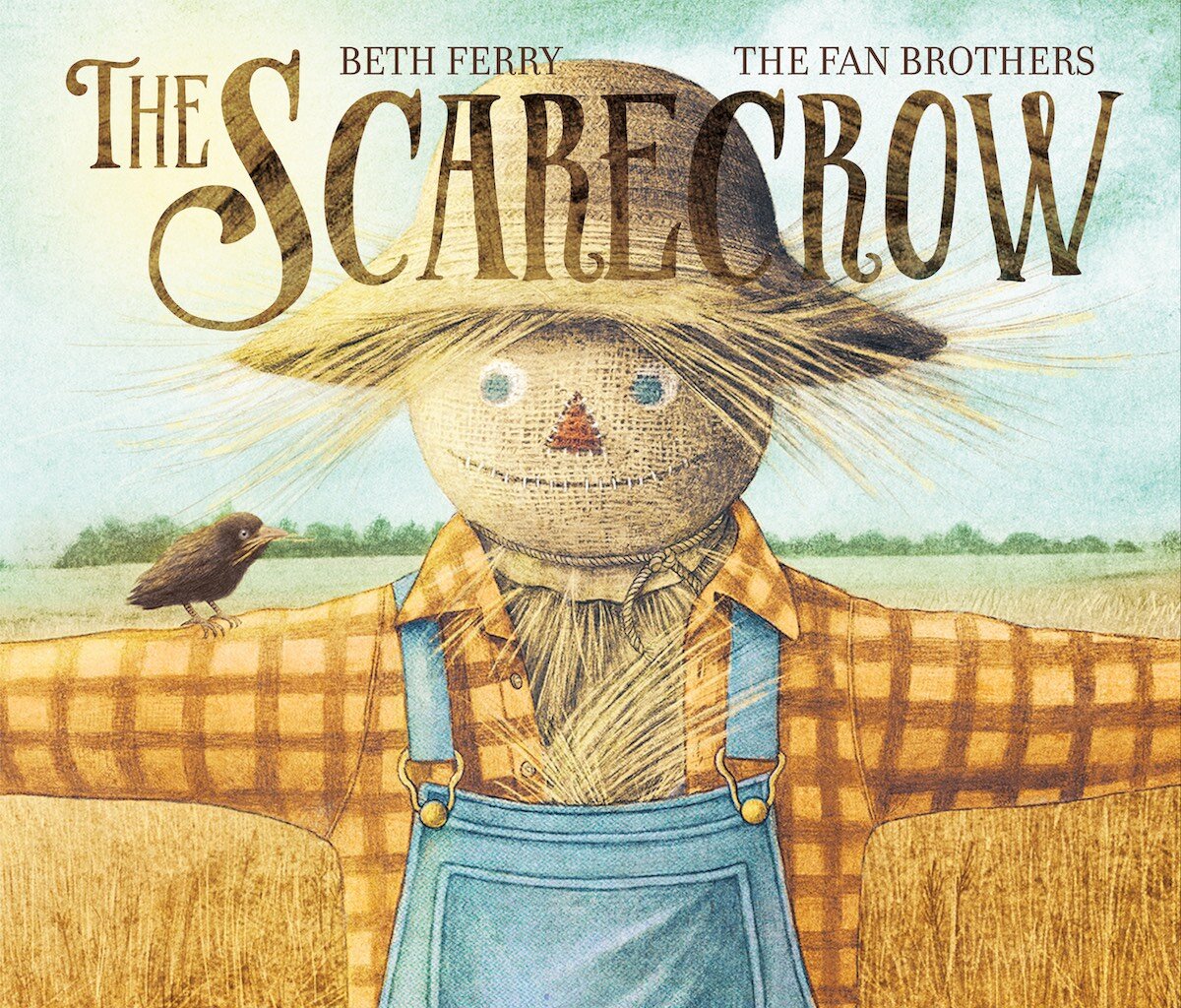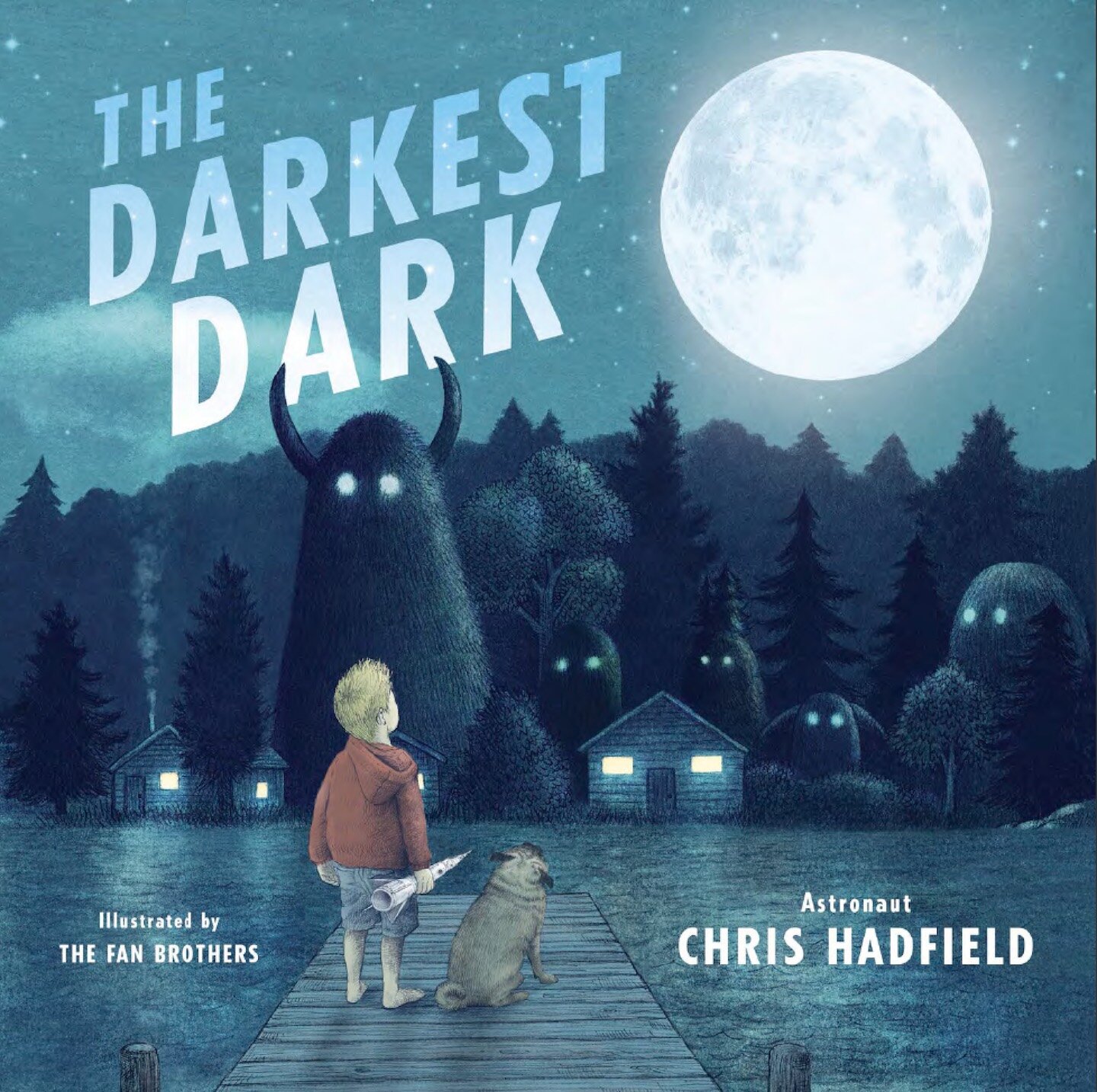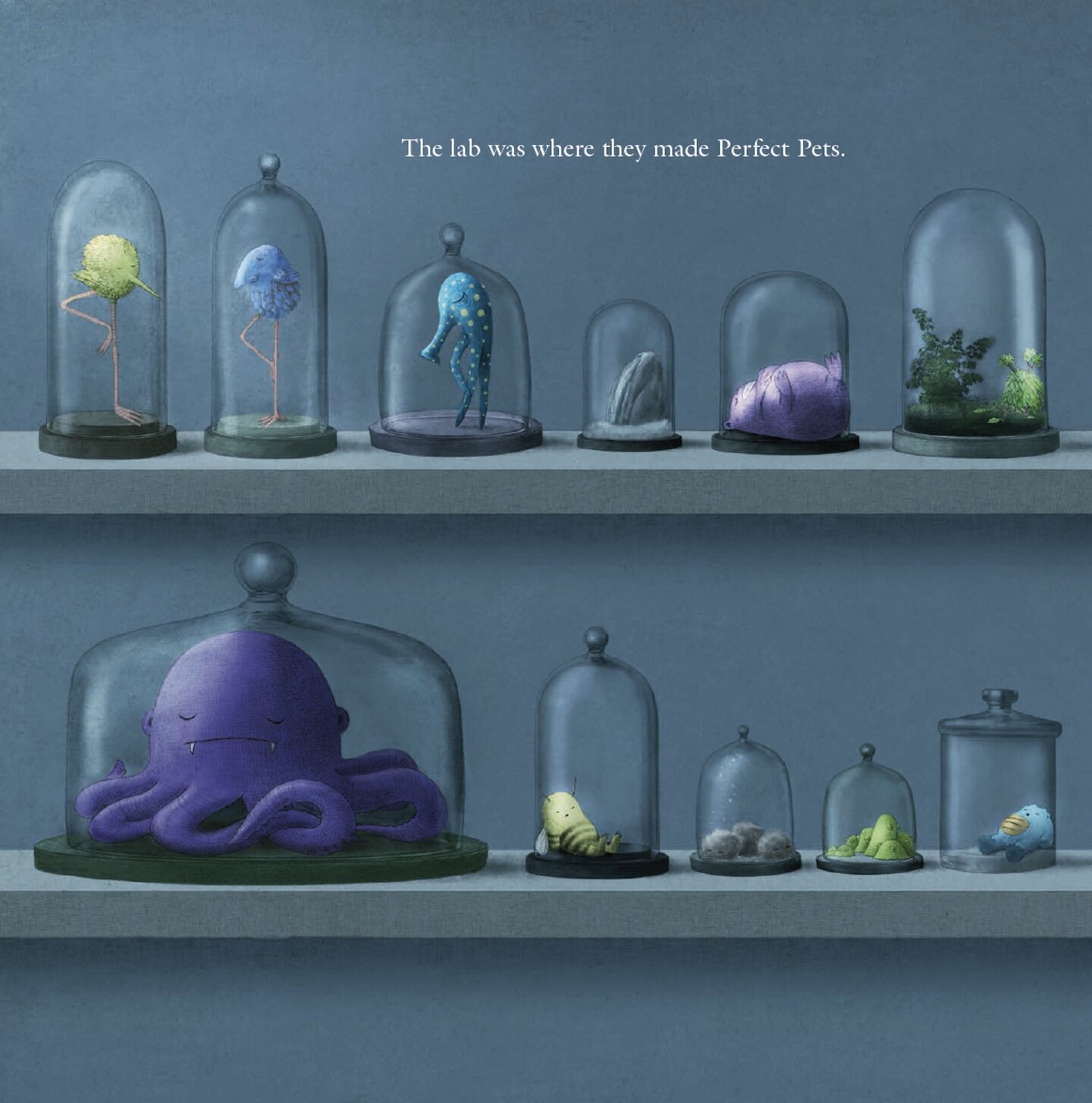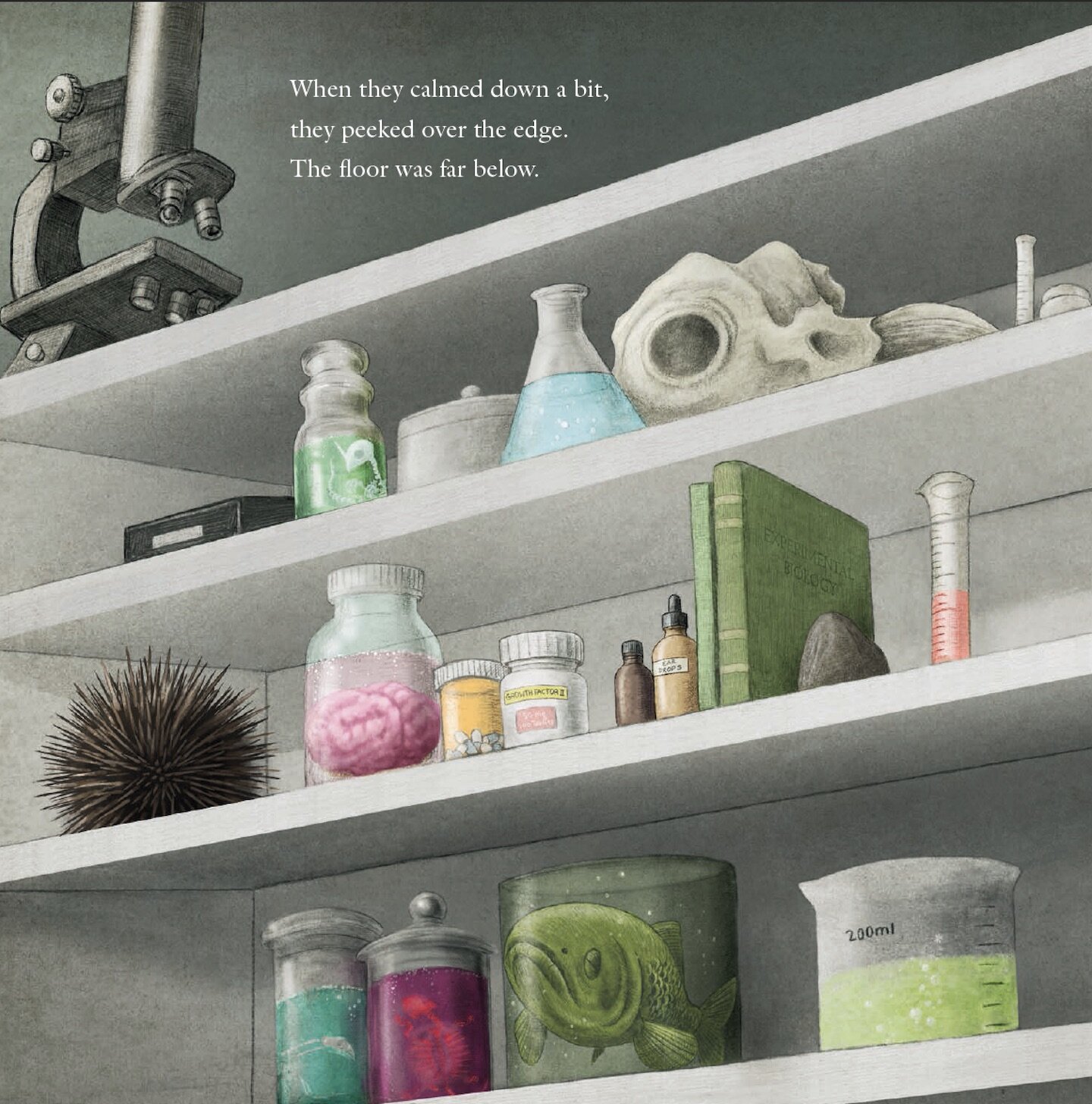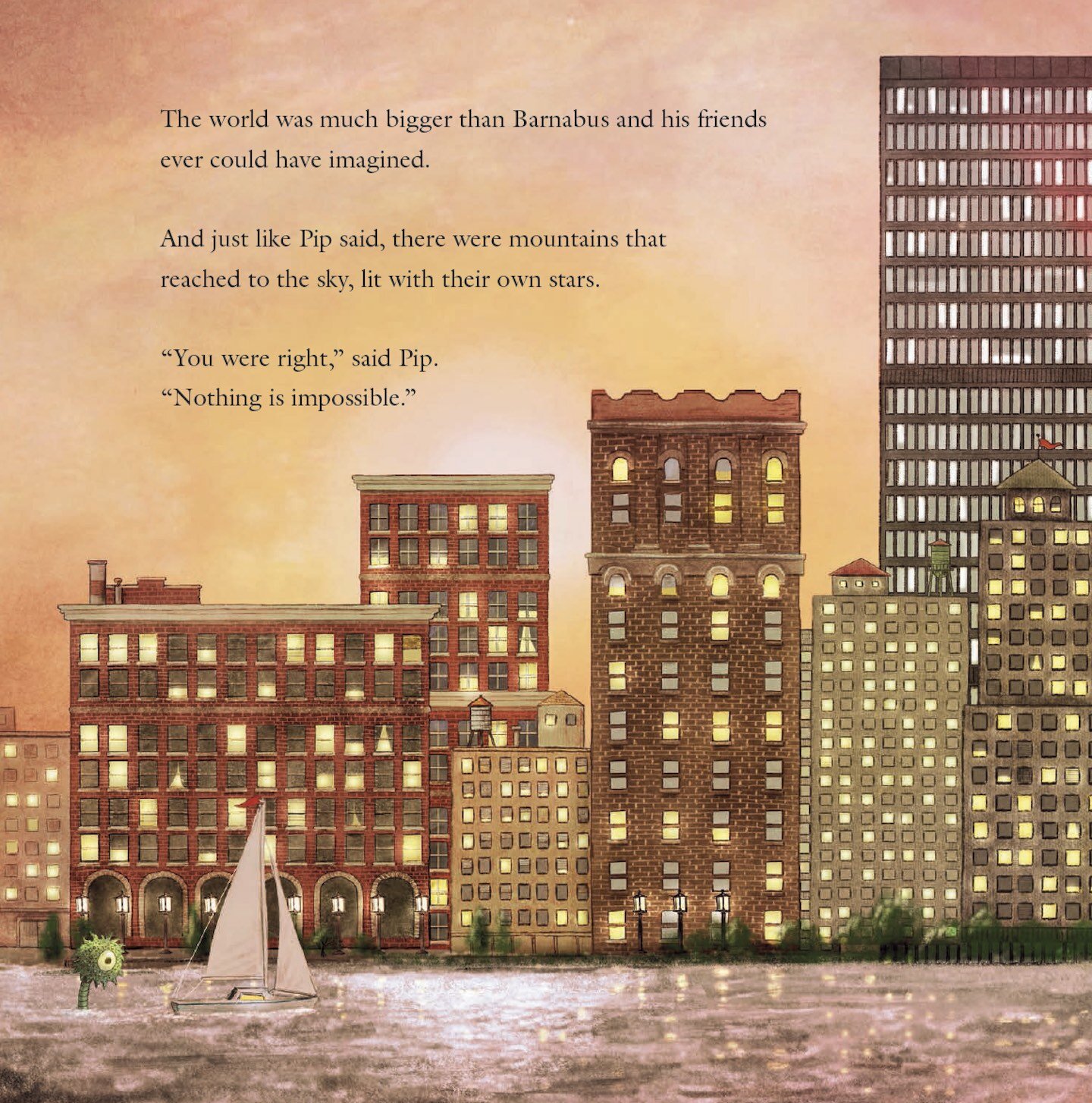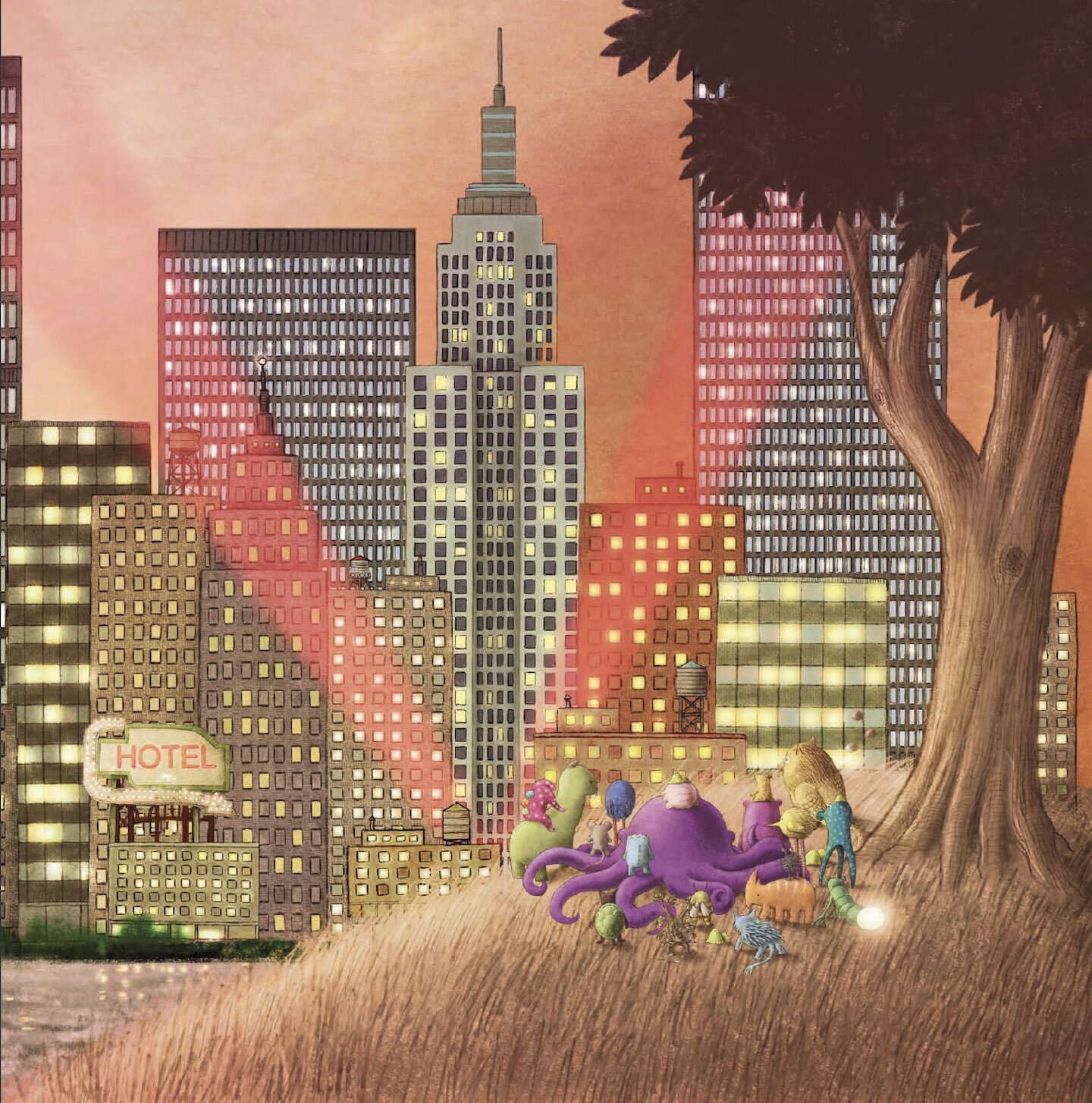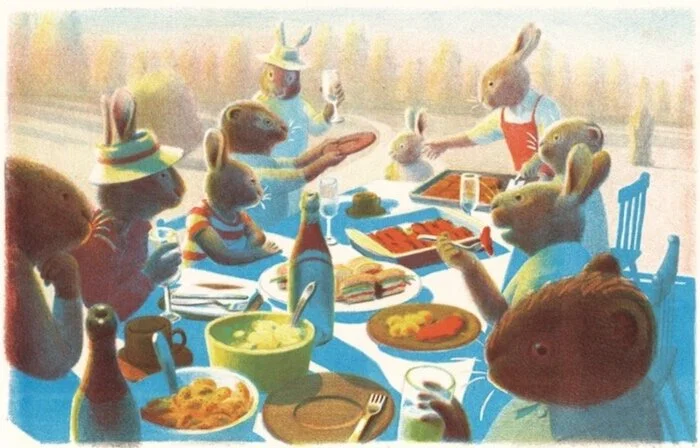An Interview with The Fan Brothers
Eric and Terry Fan
October 11, 2020
We interviewed Eric and Terry Fan (The Fan Brothers), award-winning illustrators and authors of children’s picture books. In 2018, Ocean Meets Sky was a finalist for The Governor General’s Literary Award and in 2019, it was shortlisted for The Kate Greenaway Medal. They live and work in Toronto, Canada.
A Selection of Work
With The Barnabus Project, is there a particular illustration where you reached a point where you felt it was just “right”? If so, which one and can you describe?
Eric: For me it would be the spread with Barnabus dreaming of seeing the stars. It’s an emotional turning point for the story, so it was important to get right, even though it’s a simple spread. We originally didn’t have the imaginary stars in the scene, but once we added those the scene felt complete.
Interior spread from The Barnabus Project, The Fan Brothers
Terry: I feel the same way about that spread. The confinement of his little bell jar juxtaposed against the backdrop of stars/his dreams is such a wonderful moment. It has lovely poetry to it and the same sentiment is echoed in some of the other spreads. I think it helped to really emphasize the underlying themes, but in a visual way, which is what makes it so effective.
Cover of The Barnabus Project, The Fan Brothers
How does your shared development—of concept, story and illustration—using a creative collaboration, work for your books?
Eric: I think collaborating on a book has the same benefits of any collaboration. Each person is bringing a slightly different outlook, and different skills and strengths, so hopefully the end project reflects that diversity. It can be tricky to navigate at times, but also rewarding. In the case of The Barnabus Project, it was the first time collaborating on a picture book with our younger brother Devin (although we had worked with him before on other projects).
Eric, Terry and Devin Fan —photo by Michelle Quance
Terry: I would compare it to being in a band and creating music. Everyone plays a different instrument but the end result (hopefully) is a seamless and coherent song that unifies all those diverse contributions. For The Barnabus Project it was a trio instead of a duo.
Interior spread from The Barnabus Project, The Fan Brothers
Interior spread from The Barnabus Project, The Fan Brothers
What led you both to pursuing children’s picture book authorship and illustration as your careers?
Eric: I had worked on various picture book ideas with both my brothers when I was younger. I think it’s a form that always appealed to me. The Barnabus Project itself is an idea that Devin had about 25 years ago, and it was always an idea we had in the back of our minds. Sometimes it’s a question of timing and serendipity.
Character sketches for The Barnabus Project, The Fan Brothers
Terry: That’s an unexpectedly tough question because my path towards working on picture books was a winding one, with many obstacles, dead ends and detours along the way. I’ve always loved picture books, but had no clue as to how to pursue such a career. After a few years of working as an independent artist and selling my work online, the opportunity basically just presented itself. Eric and I were both quite successful as independent artists and had a lot of visibility on sites such as Society6 and Redbubble. Our agent, Kirsten Hall, spotted our work on Society6 and emailed us out of the blue, asking us whether we were interested in illustrating picture books. She was just starting her own literary agency and we were some of the first artists to join her roster. From there, everything just took off and we’ve never looked back.
Cover of The Scarecrow, by Beth Ferry, illustration by The Fan Brothers
As young children, did either of you have an art or English teacher who encouraged or inspired you to write or create art?
Eric: When I was in junior high school I had a teacher named Mr. Holushko who was the first teacher to encourage me in art and writing. He was the first teacher to make me aware that art was a viable career path, and he was also very encouraging about my writing. For creative writing, he would sometimes read the stories I had written out to the class, which was both mortifying and electrifying. I’ll never forget his wonderful encouragement though. He was a significant enough influence that I tried to find him years later on Facebook to thank him, but I never could. Valerie Holushko, if you’re out there . . . thank you!
Interior spread from The Scarecrow, The Fan Brothers
Interior spread from The Scarecrow, The Fan Brothers
Terry: While I was attending the Ontario College of Art and Design I had many wonderful teachers, but one really stands out. His name was Hugh Mackenzie and he taught at OCAD from 1968 until 1991. I had a number of figure drawing classes with him and he had such an amazing understanding of form and technique. It was like being taught by a Renaissance artist and he definitely looked the part. He would often say “feel the form” with focused urgency as he instructed students while they were drawing. Sometimes he would do a miniature drawing alongside a particular part of a student’s drawing to demonstrate the correct angles or proportions. He had an infectious enthusiasm and love for art that still inspires me to this day.
Eric’s studio
Eric’s studio
Are there other art disciplines that you pursue as hobbies or other interests that encourage your creativity?
Eric: I like to think that many things encourage creativity, even things outside of art. Any interests you have, have a way of finding their way into your art: whether it’s science or folklore, poetry or movies. Your interests are the fuel that goes into your creativity tank.
Terry’s studio
From Terry’s studio
Terry: Yes, I feel the same. Creative expression can take many different forms, but it’s all coming from the same place. All of my varied interests have definitely influenced my work and continue to be a source of inspiration.
When your books deliver a message, is that in your minds from the start or do those messages just come about as you follow the arc of your story?
Eric: A little bit of both. I think when we start a book we have some idea of the ideas we want the story to convey, but sometimes that gets refined and focused as a project progresses.
Terry: We usually have a general idea for what the underlying message of a story is from the start but, as Eric said, it’s a process that goes through refinement and sometimes expansion. What starts as a seed of an idea can branch out. So, along with the main theme, there are often sub-themes that develop as well.
Cover of Ocean Meets Sky, The Fan Brothers
Interior spread from Ocean Meets Sky, The Fan Brothers
Do you initially work from sketches or traditional art media before moving your illustrations into a digital format for editing and color application?
Eric: All our books start with sketches and a rough dummy, before we start working on final art. I sketch in traditional media, as well as digitally. An iPad is actually a wonderful tool for doing a rough dummy because it’s very low stakes—you can always redo something or erase. Most of our books have found their start as a standalone image, where we had no plan to write a story around them. The Night Gardener actually started as a t-shirt design that Terry and I collaborated on ten years ago. Ocean Meets Sky and The Barnabus Project also started as standalone illustrations.
Terry: I would say that at the start of our book career we were primarily doing hand-drawn illustrations and then colouring them digitally in Photoshop. For the last few books, I’ve steadily adopted working on the iPad because it actually has some significant advantages over more traditional techniques. As the technology has improved, I’ve found that the freedom and versatility it offers to be quite a game-changer.
Character sketches
Do you keep any type of sketchbook for idea generation?
Eric: I used to draw exclusively in Moleskines but have started using mostly Leuchtturms now. They’re similar to Moleskine notebooks but I like the brightly-colored covers; it makes keeping them sorted by project easier. I also sketch in my iPad because it’s effortless and quick.
Dummy for The Barnabus Project, The Fan Brothers
Terry: I have some little leather-bound books from a company called Peg & Awl that I love sketching in, but these days I sketch more on the iPad because, as Eric said, the stakes are low and it encourages experimentation.
Cover of The Antlered Ship, by Dashka Slater, illustration by The Fan Brothers
Interior spread from The Antlered Ship, by Dashka Slater, illustration by The Fan Brothers
The uncoated paper for all but one of your books gives your illustrations a soft, rich, accessible feel. Is that your decision or preference? Do you get to specify?
Eric: We’ve been fortunate that the publishers we’ve worked with have always consulted us about paper stock and finish. I’ve always had a love of uncoated paper, even though it’s a little more challenging to print on in terms of color reproduction and print clarity. To me the overall aesthetic quality, and how it complements our work, is worth any trade-off though.
Terry: We both have a preference for uncoated paper, although we definitely consider all of our options for each project. Uncoated is certainly more challenging in regards to color reproduction, but aesthetically I just find it much more appealing. Also, I think it really suits our style of artwork.
Cover of The Night Gardener, The Fan Brothers
As your illustrations move from page to page in The Night Gardener, there is a rhythm of monochromatic and then a spread or two with full color. Can you elaborate on that decision process?
Eric: One of my favorite movie moments is when Dorothy steps out of her house, into the colorful world of Oz. It exemplified the transformative power of color—from drudgery into wonder, and we wanted to subtly echo that as The Night Gardener progressed; but rather than an instant transformation, a more gradual one. It’s been awhile, but I think it was our art director, Lizzy Bromley, who might have suggested it. That shows you, again, the strength of collaboration.
Terry: What Eric said!
Interior spread from The Night Gardener, The Fan Brothers
Interior spread from The Night Gardener, The Fan Brothers
Any upcoming projects you can share?
Eric and Terry: We just finished final art for our next book with Simon & Schuster called It Fell From the Sky. It’s publishing in 2021 and is about a mysterious object—a child’s marble—that falls into a garden. All the insects wonder what the object is, until a spider decides it’s his, and risks losing his friends over his attempts to capitalize on the discovery.
Are there any changes you would like to see happen in the world of children’s literature today?
Eric: It’s a cliché to say at this point, but it can’t be said enough: I’d really like to see more diversity and representation in picture books. There are a lot of voices and stories that need to be lifted up and given an opportunity to be heard. It’s starting to happen, which is wonderful, but I think there’s always more work to be done.
Interior spread from The Barnabus Project, The Fan Brothers
Terry: I very much agree with Eric and think there’s always room for more diversity. I’d also love to see publishers taking more chances on stories that are perhaps challenging or unconventional in some way. As a kid, I was always attracted to the more unusual books, which acted as a springboard for my imagination. I wonder if some of those books would even be considered today. I understand there are always economic considerations and questions of marketability, but I think there’s a real danger of missing out on something incredible by playing it too safe. I’d consider The Barnabus Project to be a pretty unusual book because of its themes and long page length, but we were lucky that our publisher, Tara Walker, believed in us enough to take that leap.
Thank you for such a engaging look into your creative process and work.
A selection of The Fan Brothers’ work
For more on The Fan Brothers:
All images used with permission by The Fan Brothers, Tundra Books, Simon & Schuster Books for Young Readers, Harper Collins, Random House, and Atheneum Books for Young Readers.

